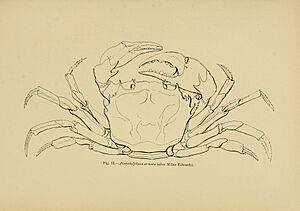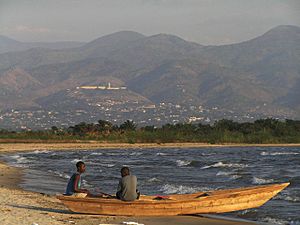Platythelphusa facts for kids
Quick facts for kids Platythelphusa |
|
|---|---|
 |
|
| Platythelphusa armata | |
| Scientific classification | |
| Kingdom: | |
| Phylum: | |
| Subphylum: | |
| Class: | |
| Order: | |
| Infraorder: | |
| Family: | |
| Genus: |
Platythelphusa
A. Milne-Edwards, 1887
|
| Type species | |
| Platythelphusa armata A. Milne-Edwards, 1887 |
|
| Species | |
|
|
Platythelphusa is a group of freshwater crabs that live only in Lake Tanganyika. This lake is located in Africa. These crabs are special because they are the only group of crabs to have developed and spread out in a freshwater lake. This happened quite recently in history, probably since the Pliocene era. It's a bit like how many different types of cichlid fish also developed in Lake Tanganyika. Only one other type of freshwater crab, Potamonautes platynotus, lives in Lake Tanganyika.
Contents
Discovering Platythelphusa Crabs
The first Platythelphusa crab was found in Lake Tanganyika in 1887. A scientist named Alphonse Milne-Edwards described it. He thought it was so different from other crabs that he gave it its own new group, called Platythelphusa armata.
Later, in 1899, another scientist named W. A. Cunnington found a second species. He also put it in a new group called Limnothelphusa maculata. He then found a third species, Platythelphusa conculata. Eventually, Cunnington realized that all three crabs belonged to the same main group. So, he decided that Limnothelphusa was actually the same as Platythelphusa.
In 1952, another scientist named Capart added four more new species to the Platythelphusa group. These were P. denticulata, P. echinata, P. polita, and P. tuberculata. Since then, two more species, P. immaculata and P. praelongata, have been discovered.
Where Platythelphusa Crabs Live
All nine species of Platythelphusa crabs live in the shallow parts of Lake Tanganyika. They are found near the edges of the lake. Lake Tanganyika borders four countries: Burundi, the Democratic Republic of the Congo, Tanzania, and Zambia.
Some species, like P. armata and P. conculcata, have been found in all four countries. P. polita lives in all countries except Zambia. Other species, like P. echinata and P. tuberculata, are found in Burundi and Tanzania. P. maculata lives in Tanzania and Zambia. Some species are known from only one country, such as P. praelongata in Zambia, and P. denticulata and P. immaculata in Tanzania.
Scientists are still learning about these crabs. It's possible that some species live in more places than we currently know.
Types of Platythelphusa Crabs
There are nine known species of Platythelphusa crabs. Each one has unique features and habitats within Lake Tanganyika.
Platythelphusa armata
This is the biggest species in the group. It can grow up to 6 centimeters (about 2.4 inches) wide across its shell. Because it's so large, people sometimes catch these crabs for food. Adult P. armata crabs live in water that is 5 to 30 meters (about 16 to 98 feet) deep. Younger crabs live in shallower water, from 1 to 10 meters (about 3 to 33 feet) deep. They often hide in empty shells of a snail called Neothauma tanganyicense. Scientists are not worried about this crab species, as it is common.
Platythelphusa conculcata
This crab species is found in water that is 20 to 60 meters (about 66 to 197 feet) deep. Scientists are not worried about its survival.
Platythelphusa denticulata
P. denticulata has only been found in a few places in Tanzania. Even though it might not have a very large population, there is no sign that its numbers are decreasing. Scientists are not worried about this species.
Platythelphusa echinata
This crab lives in water 5 to 30 meters (about 16 to 98 feet) deep. It is found along the shores of Tanzania and Burundi in Lake Tanganyika. It prefers areas with rocks or sand. Sometimes, it also uses old Neothauma snail shells for shelter.
Platythelphusa immaculata
Only about 25 specimens of P. immaculata have ever been found. However, scientists believe there are no clear threats to its survival, so they are not worried about it.
Platythelphusa maculata
P. maculata lives on sand and rocks. It can also be found in Neothauma shells. It lives in water from 1 to 60 meters (about 3 to 197 feet) deep. Scientists are not worried about this species.
Platythelphusa polita
This crab species also lives on sand and rocks, and sometimes in Neothauma shells. It is found in water that is 5 to 60 meters (about 16 to 197 feet) deep. Scientists are not worried about its population.
Platythelphusa praelongata
P. praelongata lives in the deepest water of all Platythelphusa species. The only known specimen was found at a depth of 40 to 80 meters (about 131 to 262 feet) near Mbita Island. Because so little is known about this crab, scientists need more information to decide if it is at risk.
Platythelphusa tuberculata
P. tuberculata has longer legs than the other species. It lives at the northern end of Lake Tanganyika in muddy areas. This crab has been found in the stomachs of fish, including Chrysichthys brachynema and Bathybagrus stappersii. This means it is a food source for some fish in the lake.


